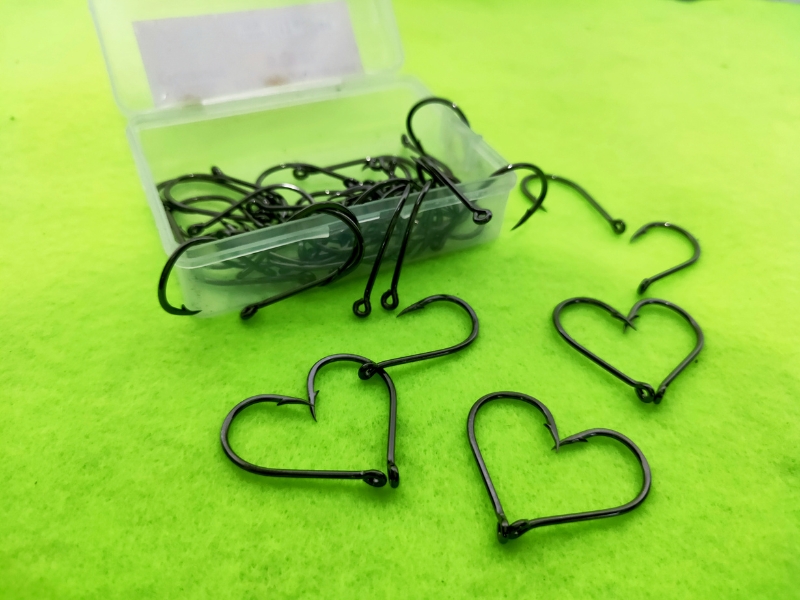A fishing hook is the most essential piece of fishing equipment. Fishing would be impossible without fishing hooks because no matter how good, no rod or reel can hook a fish to a line.
But how are fishing hooks made? The process of making fish hooks isn’t very complicated. A straight wire is cut into pieces – one end is honed into a sharp point, while the eye is formed on the other end. The piece of wire is then bent around a mandrel, creating the hook’s final shape. Fish hooks are then tempered or heat treated.
Keep reading to discover what material fishing hooks are made of and where they are manufactured. This article will also tell you what is the most durable and the most expensive fishing hook.
What Are Fishing Hooks Made Of?
Over the years, fishing hooks have been made using many different materials. Wood, bone, shells, horn, stone, bronze, and iron are a few materials used to manufacture freshwater fishing hooks.
Modern fish hooks are manufactured from high carbon steel, stainless steel, or steel alloy with vanadium. These days, high-carbon steel and stainless-steel types of metal wire are most commonly used to produce fish hooks.
Stainless steel has been used longer than high-carbon steel to make fish hooks. Although stainless steel isn’t as strong as high carbon, it’s much more corrosion-resistant which is a significant advantage for saltwater anglers.
Stainless steel contains nickel which protects against rust. The more nickel in a stainless-steel blend, the lower the chances of corrosion. On the downside, a higher nickel content makes stainless steel brittle, which isn’t something anglers want in their fishing hooks.
The biggest issue with stainless steel fish hooks is that they aren’t always good for fish. If a stainless-steel hook is deep in the fish and breaks, it won’t rust, and the fish might die. This is why stainless steel hooks are illegal to use in some fisheries.
The ban on stainless steel fishing hooks prompted many manufacturers to start making carbon steel fishing hooks. While carbon steel hooks rust, the higher the carbon content, the tougher the carbon becomes.
Stainless steel hooks may break under a lot of pressure, but carbon steel hooks are more likely to bend, keeping the fish hooked on a fishing line. Because carbon steel is a stronger material than stainless steel, carbon fish hooks are thinner, which comes in handy when hooking a fish.
How Are Fishing Hooks Made?

The process of manufacturing fish hooks is not very complicated. A fish hook is made by cutting a straight length of steel or carbon wire into pieces. One end of the wire piece is then sharpened to form a sharp point, and the other end is bent to create an eye.
The wire is then bent around a mandrel to form the hook’s final shape. At this time in the manufacturing process, the wire is so soft that you can bend it using only your hands.
Manufacturers often cold-forge or compress saltwater fishing hooks to strengthen the hook and make them ready for fishing. The hooks are also tempered or heat-treated, which alters the metal molecularly, concentrating the carbon and removing the impurities.
The optimum heating temperature varies depending on the hook’s size, type, and wire gauge. After the tempering process, the hooks are slowly cooled and intermittently dipped in oil. When completely cooled, the fishing hook is ready to be plated.
What Fishing Hooks Are Made in the USA?
Fishing hooks are manufactured by fishing companies worldwide. Many different types of fishing hooks are produced in the USA by American fishing companies.
Some of the best-known names in the fishing industry, including Eagle Claw, Berkley, Owner, and Ronn Lucas, Sr & Friends, manufacture fishing hooks in the USA. Many other large fishing tackle companies, like Mustard, manufacture their fishing hooks in China or other Asian countries.
What Is the Most Durable Fishing Hook?
The best fishing brands that produce durable and reliable fishing hooks are Eagle Claw, Mustard, Owner, and Gamakatsu. These brands offer a wide range of durable fishing hooks for saltwater and freshwater fishing.
When choosing a durable fishing hook, consider your fishing needs and the type of fish you’re trying to catch. When targeting bass, choose Owner or Panther Marti fishing hooks. But if you’re targeting trout or salmon, VMC or Rapala are a better choice.
What Is the Most Expensive Fishing Hook?
The Mustard Super Marlin 7761 was the world’s most expensive fishing hook. Known in the 1950s as the “Cadillac hook,” the Mustard Super Marlin 7761 was priced the same as a new model of Cadillac.
The Mustard Super Marlin 7761 was handmade with a braised and forged eye. This hook had a knife point for excellent hook penetration without sacrificing holding ability. The most expensive hook in the world was also strength tested to hold without failure.
Produced initially by Mustard in Norway, this hand-crafted hook stopped being manufactured in the 1960s because of high production costs. However, production has been resumed using modern materials and manufacturing processes. The legacy of the world’s most expensive fishing hook now lives through the Super Marling 7761Z series.
Conclusion
Over the centuries, fishing hooks were made using different materials, including bone, rock, wood, bronze, and iron. Modern-day fish hooks are made using stainless steel or carbon steel and are much more durable and reliable than original fishing hooks.
The way fishing hooks are manufactured is relatively simple. A straight steel wire is cut into pieces which are then sharpened and bent to form a point, eye, and the hook’s signature shape.
Most fishing hooks are very soft at the beginning of the manufacturing process but are heat-treated or tempered to become strong and durable. The strengthening process is the most crucial stage of hook making and molecularly alters the metal removing the impurities which could cause a hook to break.